Treatment and Management of Chronic Heart Failure: Nursing Strategies
VerifiedAdded on 2021/06/17
|8
|1847
|29
Report
AI Summary
This report examines the nursing strategies and interventions employed in the long-term treatment and management of chronic heart failure (CHF), focusing on a case study of Mr. M. W., a 66-year-old patient in a nursing care home. The report addresses lifestyle modifications, including the importance of weight management and moderate physical activity to improve quality of life and reduce neurohumoral activation. It then explores the impact of nutrition, emphasizing careful control of caloric intake, amino acid supplementation, and dietary fat content, particularly omega-3 fatty acids, to manage inflammation and cardiovascular events. Finally, the report discusses fluid management, highlighting the importance of achieving a patient's dry weight through fluid restriction, and advising on the importance of patient education regarding fluid and salt intake to enhance independence and well-being. The report references several studies and guidelines to support the nursing interventions discussed.
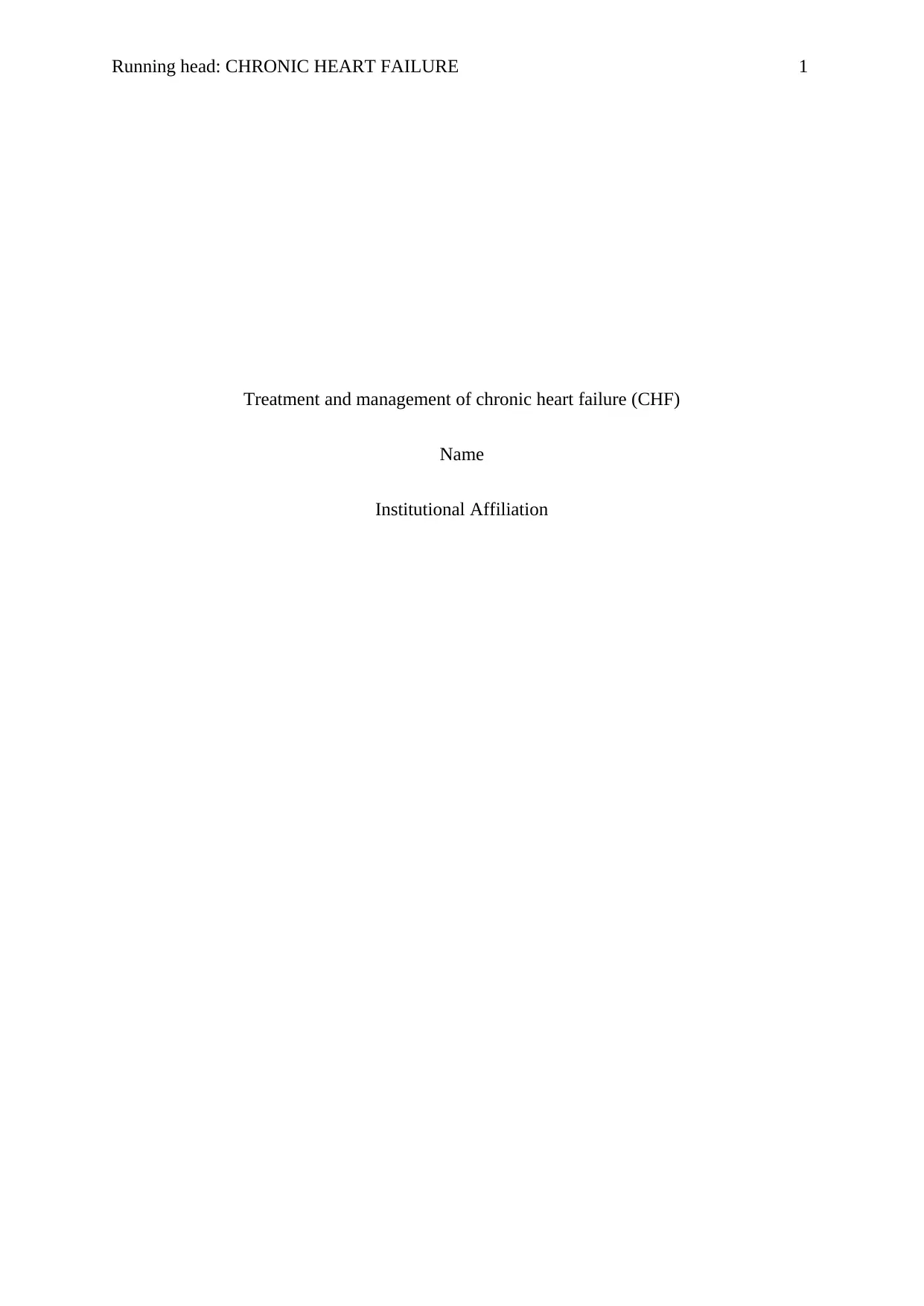
Running head: CHRONIC HEART FAILURE 1
Treatment and management of chronic heart failure (CHF)
Name
Institutional Affiliation
Treatment and management of chronic heart failure (CHF)
Name
Institutional Affiliation
Paraphrase This Document
Need a fresh take? Get an instant paraphrase of this document with our AI Paraphraser
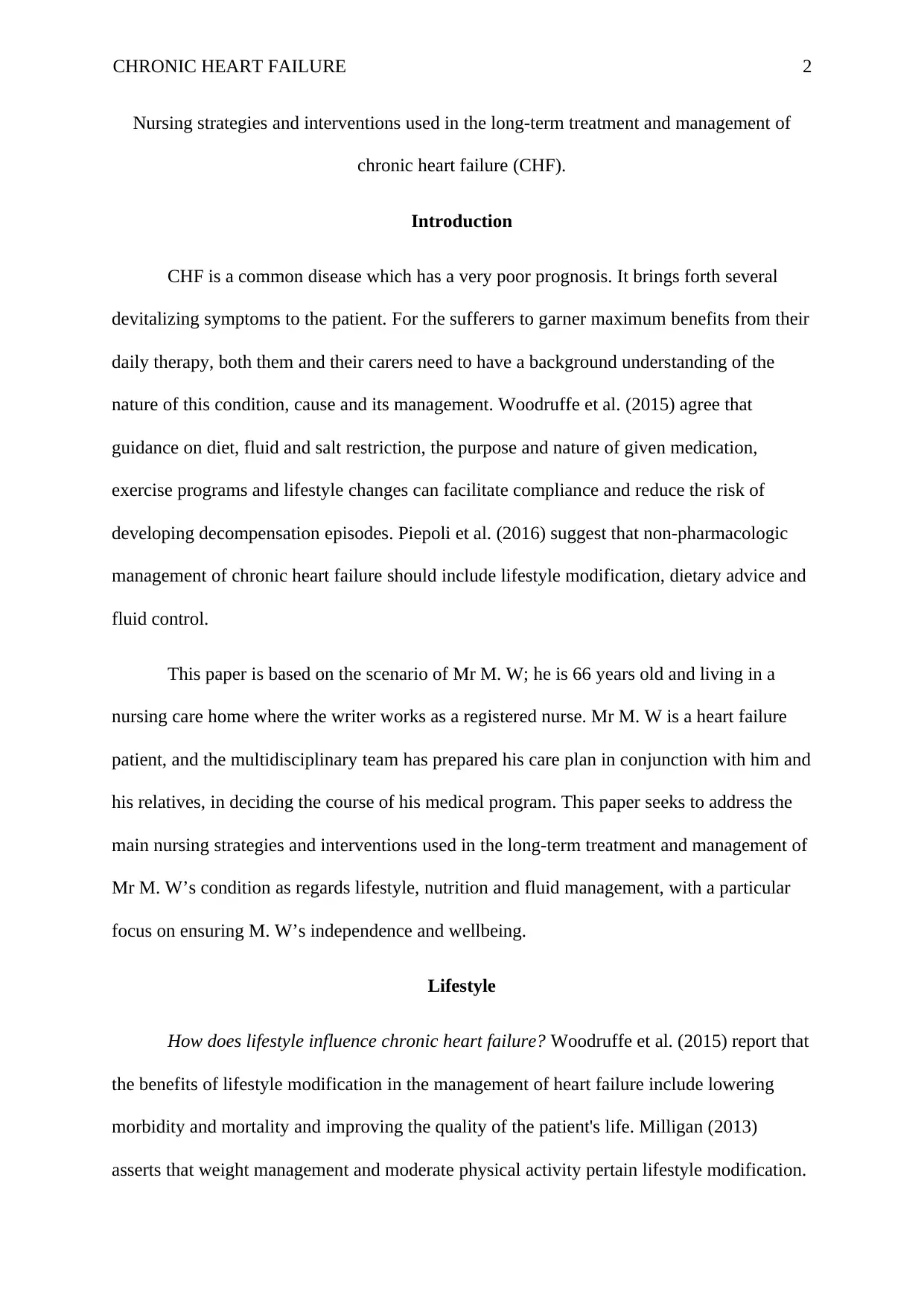
CHRONIC HEART FAILURE 2
Nursing strategies and interventions used in the long-term treatment and management of
chronic heart failure (CHF).
Introduction
CHF is a common disease which has a very poor prognosis. It brings forth several
devitalizing symptoms to the patient. For the sufferers to garner maximum benefits from their
daily therapy, both them and their carers need to have a background understanding of the
nature of this condition, cause and its management. Woodruffe et al. (2015) agree that
guidance on diet, fluid and salt restriction, the purpose and nature of given medication,
exercise programs and lifestyle changes can facilitate compliance and reduce the risk of
developing decompensation episodes. Piepoli et al. (2016) suggest that non-pharmacologic
management of chronic heart failure should include lifestyle modification, dietary advice and
fluid control.
This paper is based on the scenario of Mr M. W; he is 66 years old and living in a
nursing care home where the writer works as a registered nurse. Mr M. W is a heart failure
patient, and the multidisciplinary team has prepared his care plan in conjunction with him and
his relatives, in deciding the course of his medical program. This paper seeks to address the
main nursing strategies and interventions used in the long-term treatment and management of
Mr M. W’s condition as regards lifestyle, nutrition and fluid management, with a particular
focus on ensuring M. W’s independence and wellbeing.
Lifestyle
How does lifestyle influence chronic heart failure? Woodruffe et al. (2015) report that
the benefits of lifestyle modification in the management of heart failure include lowering
morbidity and mortality and improving the quality of the patient's life. Milligan (2013)
asserts that weight management and moderate physical activity pertain lifestyle modification.
Nursing strategies and interventions used in the long-term treatment and management of
chronic heart failure (CHF).
Introduction
CHF is a common disease which has a very poor prognosis. It brings forth several
devitalizing symptoms to the patient. For the sufferers to garner maximum benefits from their
daily therapy, both them and their carers need to have a background understanding of the
nature of this condition, cause and its management. Woodruffe et al. (2015) agree that
guidance on diet, fluid and salt restriction, the purpose and nature of given medication,
exercise programs and lifestyle changes can facilitate compliance and reduce the risk of
developing decompensation episodes. Piepoli et al. (2016) suggest that non-pharmacologic
management of chronic heart failure should include lifestyle modification, dietary advice and
fluid control.
This paper is based on the scenario of Mr M. W; he is 66 years old and living in a
nursing care home where the writer works as a registered nurse. Mr M. W is a heart failure
patient, and the multidisciplinary team has prepared his care plan in conjunction with him and
his relatives, in deciding the course of his medical program. This paper seeks to address the
main nursing strategies and interventions used in the long-term treatment and management of
Mr M. W’s condition as regards lifestyle, nutrition and fluid management, with a particular
focus on ensuring M. W’s independence and wellbeing.
Lifestyle
How does lifestyle influence chronic heart failure? Woodruffe et al. (2015) report that
the benefits of lifestyle modification in the management of heart failure include lowering
morbidity and mortality and improving the quality of the patient's life. Milligan (2013)
asserts that weight management and moderate physical activity pertain lifestyle modification.
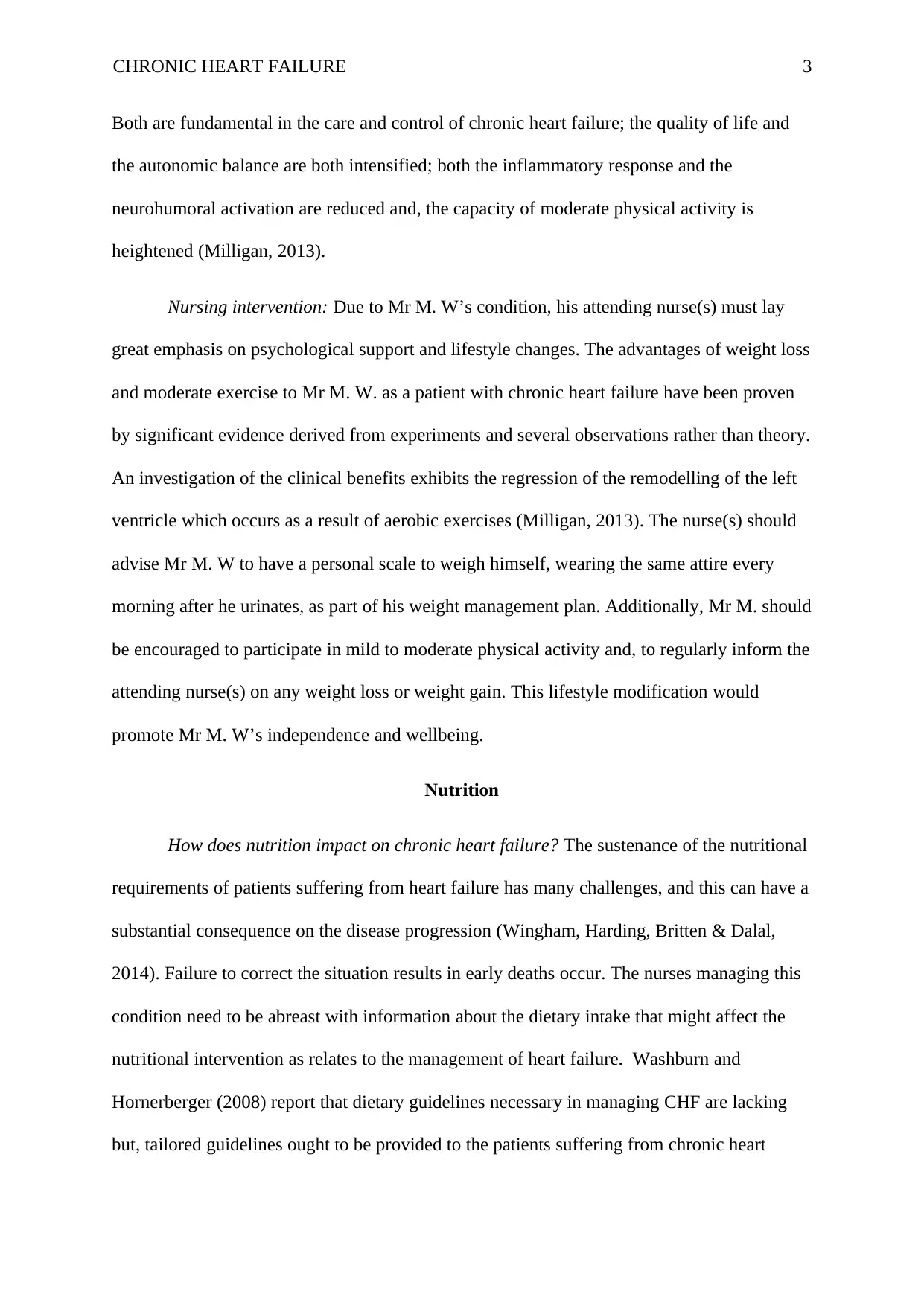
CHRONIC HEART FAILURE 3
Both are fundamental in the care and control of chronic heart failure; the quality of life and
the autonomic balance are both intensified; both the inflammatory response and the
neurohumoral activation are reduced and, the capacity of moderate physical activity is
heightened (Milligan, 2013).
Nursing intervention: Due to Mr M. W’s condition, his attending nurse(s) must lay
great emphasis on psychological support and lifestyle changes. The advantages of weight loss
and moderate exercise to Mr M. W. as a patient with chronic heart failure have been proven
by significant evidence derived from experiments and several observations rather than theory.
An investigation of the clinical benefits exhibits the regression of the remodelling of the left
ventricle which occurs as a result of aerobic exercises (Milligan, 2013). The nurse(s) should
advise Mr M. W to have a personal scale to weigh himself, wearing the same attire every
morning after he urinates, as part of his weight management plan. Additionally, Mr M. should
be encouraged to participate in mild to moderate physical activity and, to regularly inform the
attending nurse(s) on any weight loss or weight gain. This lifestyle modification would
promote Mr M. W’s independence and wellbeing.
Nutrition
How does nutrition impact on chronic heart failure? The sustenance of the nutritional
requirements of patients suffering from heart failure has many challenges, and this can have a
substantial consequence on the disease progression (Wingham, Harding, Britten & Dalal,
2014). Failure to correct the situation results in early deaths occur. The nurses managing this
condition need to be abreast with information about the dietary intake that might affect the
nutritional intervention as relates to the management of heart failure. Washburn and
Hornerberger (2008) report that dietary guidelines necessary in managing CHF are lacking
but, tailored guidelines ought to be provided to the patients suffering from chronic heart
Both are fundamental in the care and control of chronic heart failure; the quality of life and
the autonomic balance are both intensified; both the inflammatory response and the
neurohumoral activation are reduced and, the capacity of moderate physical activity is
heightened (Milligan, 2013).
Nursing intervention: Due to Mr M. W’s condition, his attending nurse(s) must lay
great emphasis on psychological support and lifestyle changes. The advantages of weight loss
and moderate exercise to Mr M. W. as a patient with chronic heart failure have been proven
by significant evidence derived from experiments and several observations rather than theory.
An investigation of the clinical benefits exhibits the regression of the remodelling of the left
ventricle which occurs as a result of aerobic exercises (Milligan, 2013). The nurse(s) should
advise Mr M. W to have a personal scale to weigh himself, wearing the same attire every
morning after he urinates, as part of his weight management plan. Additionally, Mr M. should
be encouraged to participate in mild to moderate physical activity and, to regularly inform the
attending nurse(s) on any weight loss or weight gain. This lifestyle modification would
promote Mr M. W’s independence and wellbeing.
Nutrition
How does nutrition impact on chronic heart failure? The sustenance of the nutritional
requirements of patients suffering from heart failure has many challenges, and this can have a
substantial consequence on the disease progression (Wingham, Harding, Britten & Dalal,
2014). Failure to correct the situation results in early deaths occur. The nurses managing this
condition need to be abreast with information about the dietary intake that might affect the
nutritional intervention as relates to the management of heart failure. Washburn and
Hornerberger (2008) report that dietary guidelines necessary in managing CHF are lacking
but, tailored guidelines ought to be provided to the patients suffering from chronic heart
⊘ This is a preview!⊘
Do you want full access?
Subscribe today to unlock all pages.

Trusted by 1+ million students worldwide
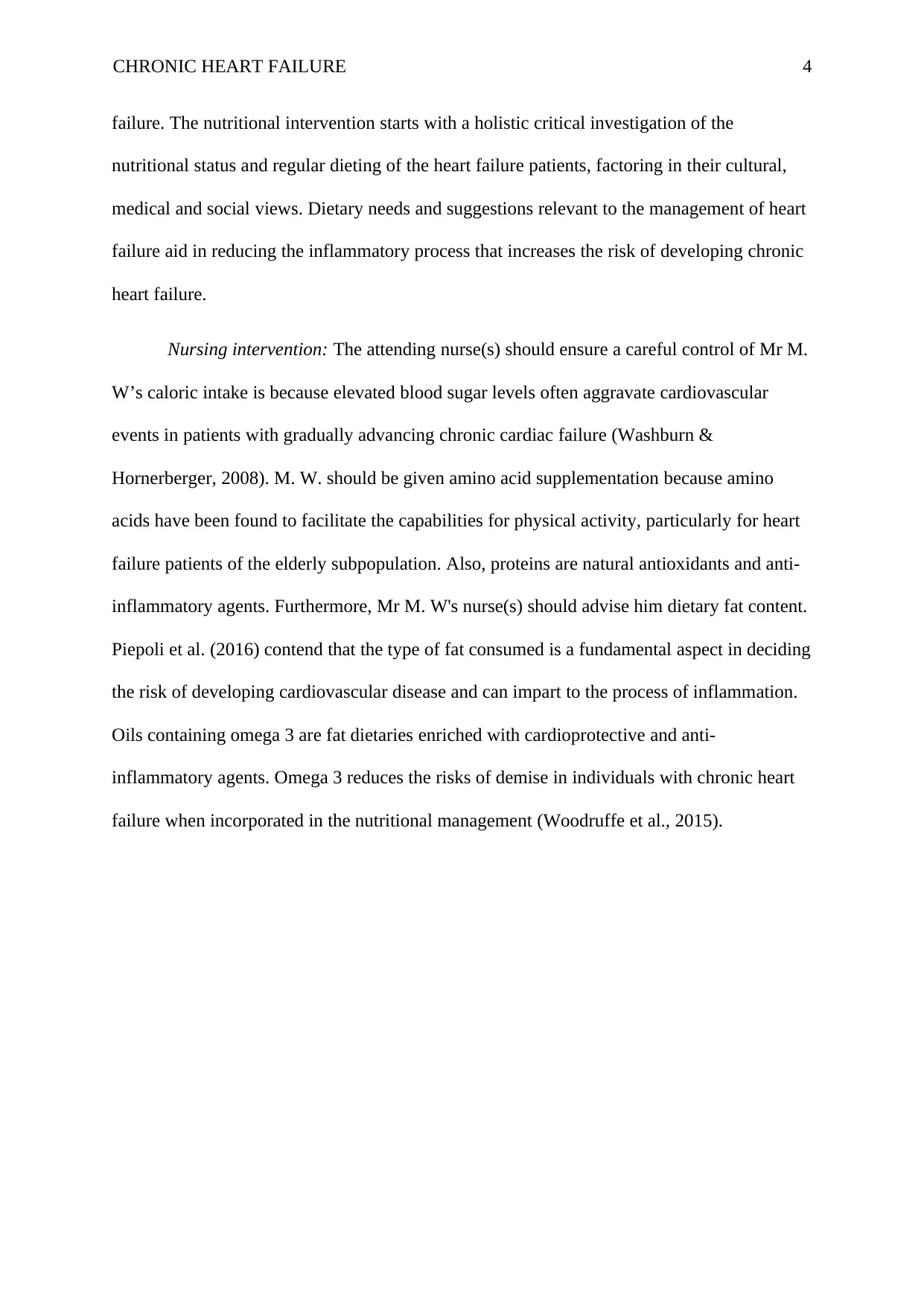
CHRONIC HEART FAILURE 4
failure. The nutritional intervention starts with a holistic critical investigation of the
nutritional status and regular dieting of the heart failure patients, factoring in their cultural,
medical and social views. Dietary needs and suggestions relevant to the management of heart
failure aid in reducing the inflammatory process that increases the risk of developing chronic
heart failure.
Nursing intervention: The attending nurse(s) should ensure a careful control of Mr M.
W’s caloric intake is because elevated blood sugar levels often aggravate cardiovascular
events in patients with gradually advancing chronic cardiac failure (Washburn &
Hornerberger, 2008). M. W. should be given amino acid supplementation because amino
acids have been found to facilitate the capabilities for physical activity, particularly for heart
failure patients of the elderly subpopulation. Also, proteins are natural antioxidants and anti-
inflammatory agents. Furthermore, Mr M. W's nurse(s) should advise him dietary fat content.
Piepoli et al. (2016) contend that the type of fat consumed is a fundamental aspect in deciding
the risk of developing cardiovascular disease and can impart to the process of inflammation.
Oils containing omega 3 are fat dietaries enriched with cardioprotective and anti-
inflammatory agents. Omega 3 reduces the risks of demise in individuals with chronic heart
failure when incorporated in the nutritional management (Woodruffe et al., 2015).
failure. The nutritional intervention starts with a holistic critical investigation of the
nutritional status and regular dieting of the heart failure patients, factoring in their cultural,
medical and social views. Dietary needs and suggestions relevant to the management of heart
failure aid in reducing the inflammatory process that increases the risk of developing chronic
heart failure.
Nursing intervention: The attending nurse(s) should ensure a careful control of Mr M.
W’s caloric intake is because elevated blood sugar levels often aggravate cardiovascular
events in patients with gradually advancing chronic cardiac failure (Washburn &
Hornerberger, 2008). M. W. should be given amino acid supplementation because amino
acids have been found to facilitate the capabilities for physical activity, particularly for heart
failure patients of the elderly subpopulation. Also, proteins are natural antioxidants and anti-
inflammatory agents. Furthermore, Mr M. W's nurse(s) should advise him dietary fat content.
Piepoli et al. (2016) contend that the type of fat consumed is a fundamental aspect in deciding
the risk of developing cardiovascular disease and can impart to the process of inflammation.
Oils containing omega 3 are fat dietaries enriched with cardioprotective and anti-
inflammatory agents. Omega 3 reduces the risks of demise in individuals with chronic heart
failure when incorporated in the nutritional management (Woodruffe et al., 2015).
Paraphrase This Document
Need a fresh take? Get an instant paraphrase of this document with our AI Paraphraser
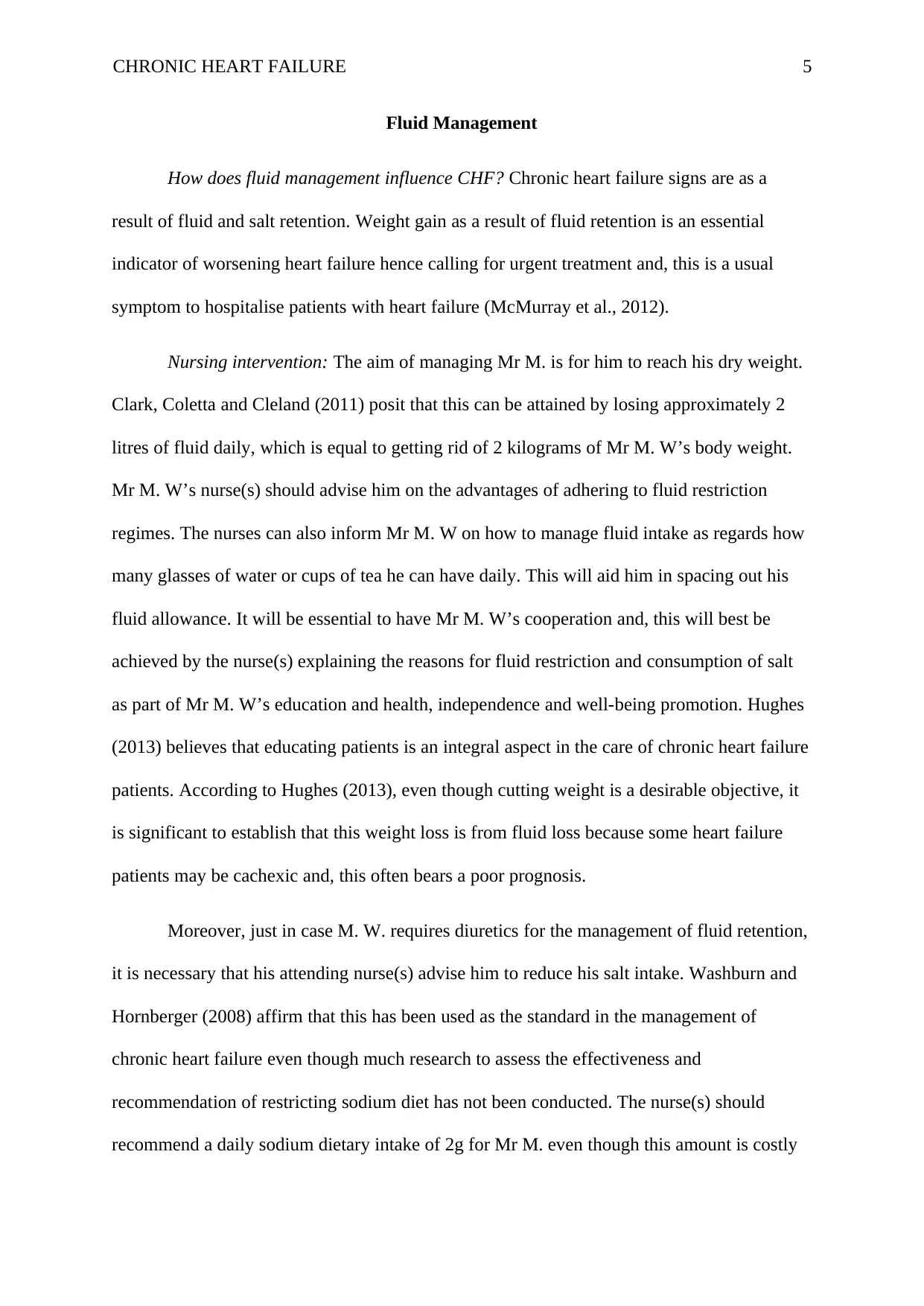
CHRONIC HEART FAILURE 5
Fluid Management
How does fluid management influence CHF? Chronic heart failure signs are as a
result of fluid and salt retention. Weight gain as a result of fluid retention is an essential
indicator of worsening heart failure hence calling for urgent treatment and, this is a usual
symptom to hospitalise patients with heart failure (McMurray et al., 2012).
Nursing intervention: The aim of managing Mr M. is for him to reach his dry weight.
Clark, Coletta and Cleland (2011) posit that this can be attained by losing approximately 2
litres of fluid daily, which is equal to getting rid of 2 kilograms of Mr M. W’s body weight.
Mr M. W’s nurse(s) should advise him on the advantages of adhering to fluid restriction
regimes. The nurses can also inform Mr M. W on how to manage fluid intake as regards how
many glasses of water or cups of tea he can have daily. This will aid him in spacing out his
fluid allowance. It will be essential to have Mr M. W’s cooperation and, this will best be
achieved by the nurse(s) explaining the reasons for fluid restriction and consumption of salt
as part of Mr M. W’s education and health, independence and well-being promotion. Hughes
(2013) believes that educating patients is an integral aspect in the care of chronic heart failure
patients. According to Hughes (2013), even though cutting weight is a desirable objective, it
is significant to establish that this weight loss is from fluid loss because some heart failure
patients may be cachexic and, this often bears a poor prognosis.
Moreover, just in case M. W. requires diuretics for the management of fluid retention,
it is necessary that his attending nurse(s) advise him to reduce his salt intake. Washburn and
Hornberger (2008) affirm that this has been used as the standard in the management of
chronic heart failure even though much research to assess the effectiveness and
recommendation of restricting sodium diet has not been conducted. The nurse(s) should
recommend a daily sodium dietary intake of 2g for Mr M. even though this amount is costly
Fluid Management
How does fluid management influence CHF? Chronic heart failure signs are as a
result of fluid and salt retention. Weight gain as a result of fluid retention is an essential
indicator of worsening heart failure hence calling for urgent treatment and, this is a usual
symptom to hospitalise patients with heart failure (McMurray et al., 2012).
Nursing intervention: The aim of managing Mr M. is for him to reach his dry weight.
Clark, Coletta and Cleland (2011) posit that this can be attained by losing approximately 2
litres of fluid daily, which is equal to getting rid of 2 kilograms of Mr M. W’s body weight.
Mr M. W’s nurse(s) should advise him on the advantages of adhering to fluid restriction
regimes. The nurses can also inform Mr M. W on how to manage fluid intake as regards how
many glasses of water or cups of tea he can have daily. This will aid him in spacing out his
fluid allowance. It will be essential to have Mr M. W’s cooperation and, this will best be
achieved by the nurse(s) explaining the reasons for fluid restriction and consumption of salt
as part of Mr M. W’s education and health, independence and well-being promotion. Hughes
(2013) believes that educating patients is an integral aspect in the care of chronic heart failure
patients. According to Hughes (2013), even though cutting weight is a desirable objective, it
is significant to establish that this weight loss is from fluid loss because some heart failure
patients may be cachexic and, this often bears a poor prognosis.
Moreover, just in case M. W. requires diuretics for the management of fluid retention,
it is necessary that his attending nurse(s) advise him to reduce his salt intake. Washburn and
Hornberger (2008) affirm that this has been used as the standard in the management of
chronic heart failure even though much research to assess the effectiveness and
recommendation of restricting sodium diet has not been conducted. The nurse(s) should
recommend a daily sodium dietary intake of 2g for Mr M. even though this amount is costly
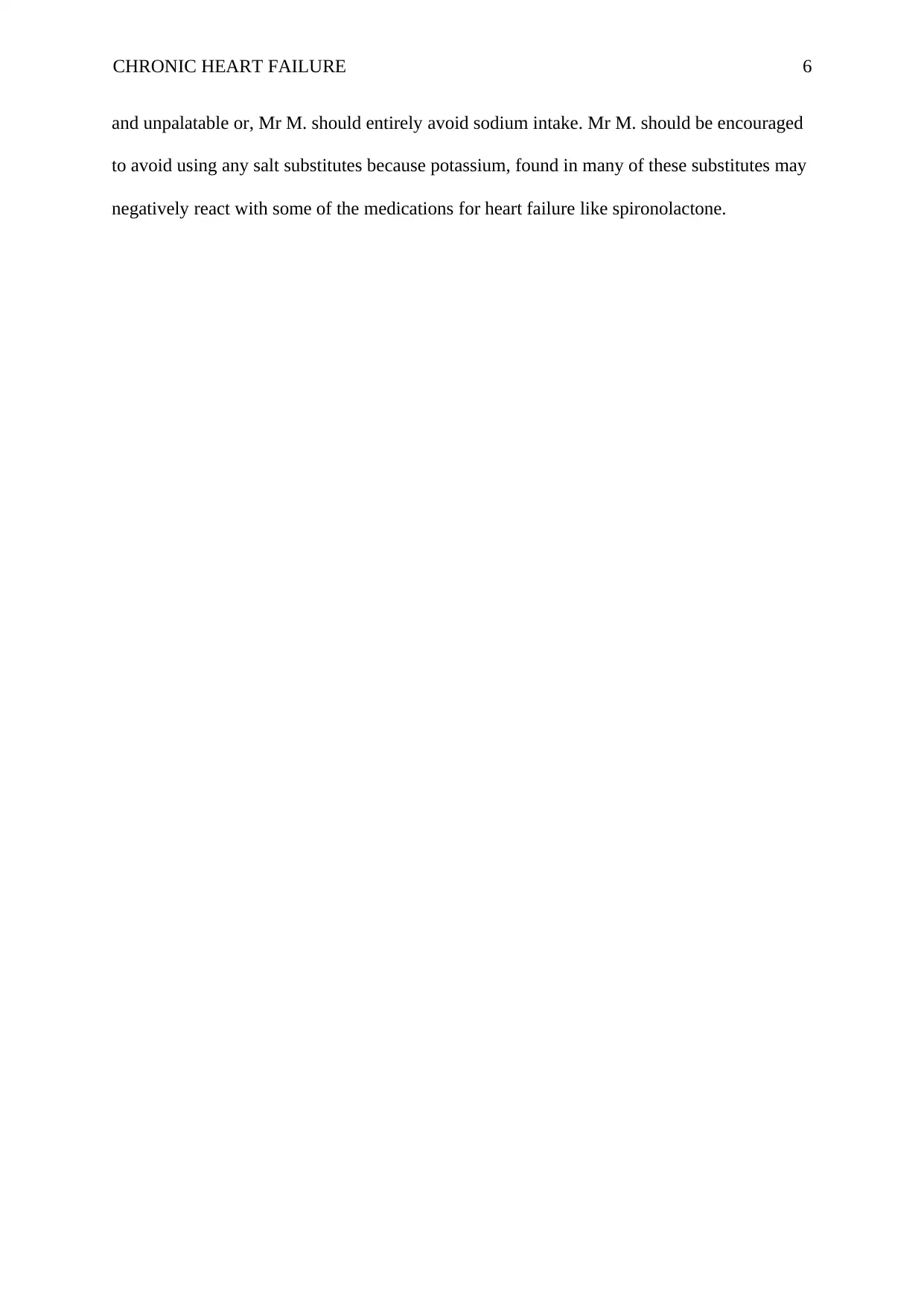
CHRONIC HEART FAILURE 6
and unpalatable or, Mr M. should entirely avoid sodium intake. Mr M. should be encouraged
to avoid using any salt substitutes because potassium, found in many of these substitutes may
negatively react with some of the medications for heart failure like spironolactone.
and unpalatable or, Mr M. should entirely avoid sodium intake. Mr M. should be encouraged
to avoid using any salt substitutes because potassium, found in many of these substitutes may
negatively react with some of the medications for heart failure like spironolactone.
⊘ This is a preview!⊘
Do you want full access?
Subscribe today to unlock all pages.

Trusted by 1+ million students worldwide
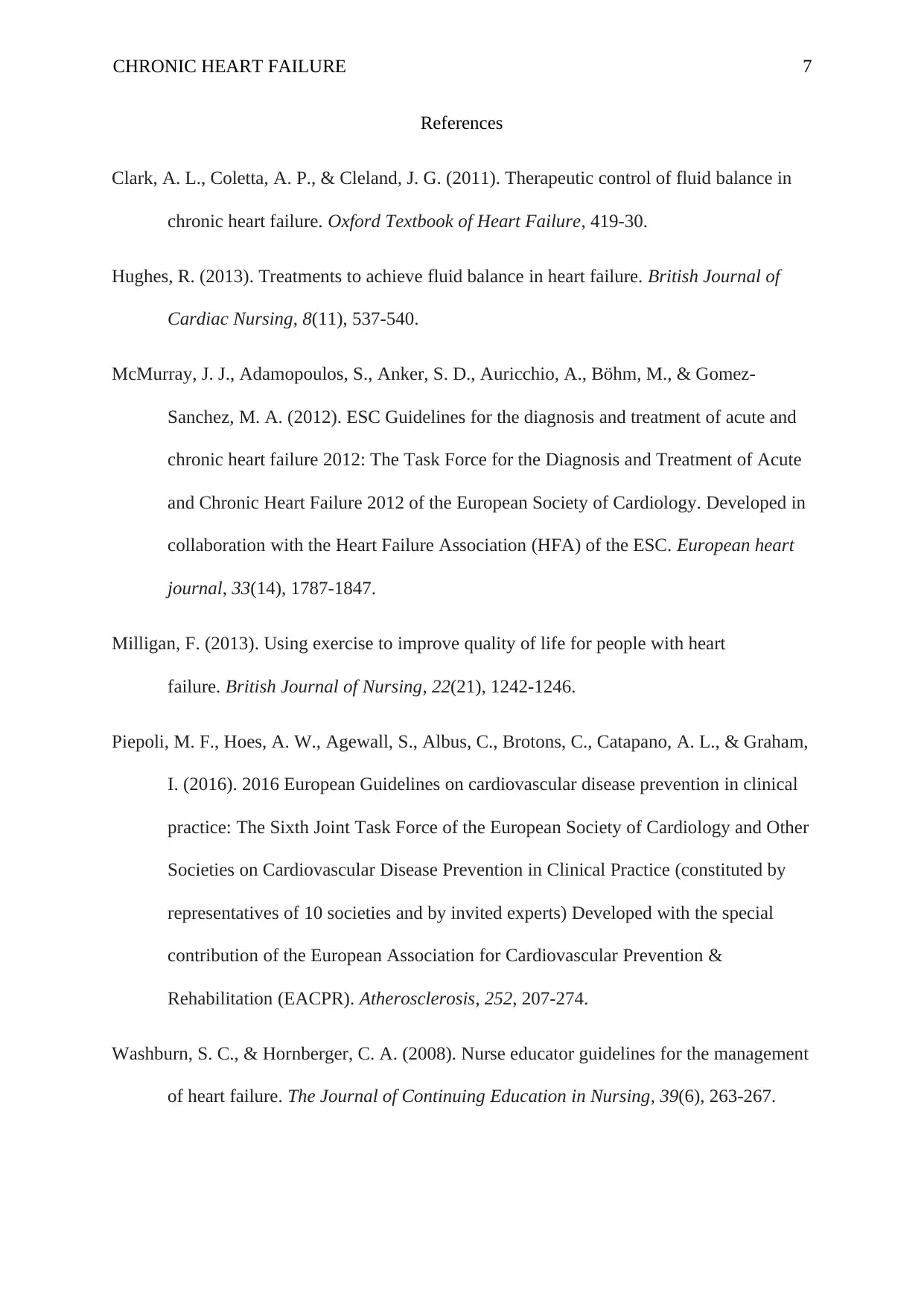
CHRONIC HEART FAILURE 7
References
Clark, A. L., Coletta, A. P., & Cleland, J. G. (2011). Therapeutic control of fluid balance in
chronic heart failure. Oxford Textbook of Heart Failure, 419-30.
Hughes, R. (2013). Treatments to achieve fluid balance in heart failure. British Journal of
Cardiac Nursing, 8(11), 537-540.
McMurray, J. J., Adamopoulos, S., Anker, S. D., Auricchio, A., Böhm, M., & Gomez-
Sanchez, M. A. (2012). ESC Guidelines for the diagnosis and treatment of acute and
chronic heart failure 2012: The Task Force for the Diagnosis and Treatment of Acute
and Chronic Heart Failure 2012 of the European Society of Cardiology. Developed in
collaboration with the Heart Failure Association (HFA) of the ESC. European heart
journal, 33(14), 1787-1847.
Milligan, F. (2013). Using exercise to improve quality of life for people with heart
failure. British Journal of Nursing, 22(21), 1242-1246.
Piepoli, M. F., Hoes, A. W., Agewall, S., Albus, C., Brotons, C., Catapano, A. L., & Graham,
I. (2016). 2016 European Guidelines on cardiovascular disease prevention in clinical
practice: The Sixth Joint Task Force of the European Society of Cardiology and Other
Societies on Cardiovascular Disease Prevention in Clinical Practice (constituted by
representatives of 10 societies and by invited experts) Developed with the special
contribution of the European Association for Cardiovascular Prevention &
Rehabilitation (EACPR). Atherosclerosis, 252, 207-274.
Washburn, S. C., & Hornberger, C. A. (2008). Nurse educator guidelines for the management
of heart failure. The Journal of Continuing Education in Nursing, 39(6), 263-267.
References
Clark, A. L., Coletta, A. P., & Cleland, J. G. (2011). Therapeutic control of fluid balance in
chronic heart failure. Oxford Textbook of Heart Failure, 419-30.
Hughes, R. (2013). Treatments to achieve fluid balance in heart failure. British Journal of
Cardiac Nursing, 8(11), 537-540.
McMurray, J. J., Adamopoulos, S., Anker, S. D., Auricchio, A., Böhm, M., & Gomez-
Sanchez, M. A. (2012). ESC Guidelines for the diagnosis and treatment of acute and
chronic heart failure 2012: The Task Force for the Diagnosis and Treatment of Acute
and Chronic Heart Failure 2012 of the European Society of Cardiology. Developed in
collaboration with the Heart Failure Association (HFA) of the ESC. European heart
journal, 33(14), 1787-1847.
Milligan, F. (2013). Using exercise to improve quality of life for people with heart
failure. British Journal of Nursing, 22(21), 1242-1246.
Piepoli, M. F., Hoes, A. W., Agewall, S., Albus, C., Brotons, C., Catapano, A. L., & Graham,
I. (2016). 2016 European Guidelines on cardiovascular disease prevention in clinical
practice: The Sixth Joint Task Force of the European Society of Cardiology and Other
Societies on Cardiovascular Disease Prevention in Clinical Practice (constituted by
representatives of 10 societies and by invited experts) Developed with the special
contribution of the European Association for Cardiovascular Prevention &
Rehabilitation (EACPR). Atherosclerosis, 252, 207-274.
Washburn, S. C., & Hornberger, C. A. (2008). Nurse educator guidelines for the management
of heart failure. The Journal of Continuing Education in Nursing, 39(6), 263-267.
Paraphrase This Document
Need a fresh take? Get an instant paraphrase of this document with our AI Paraphraser
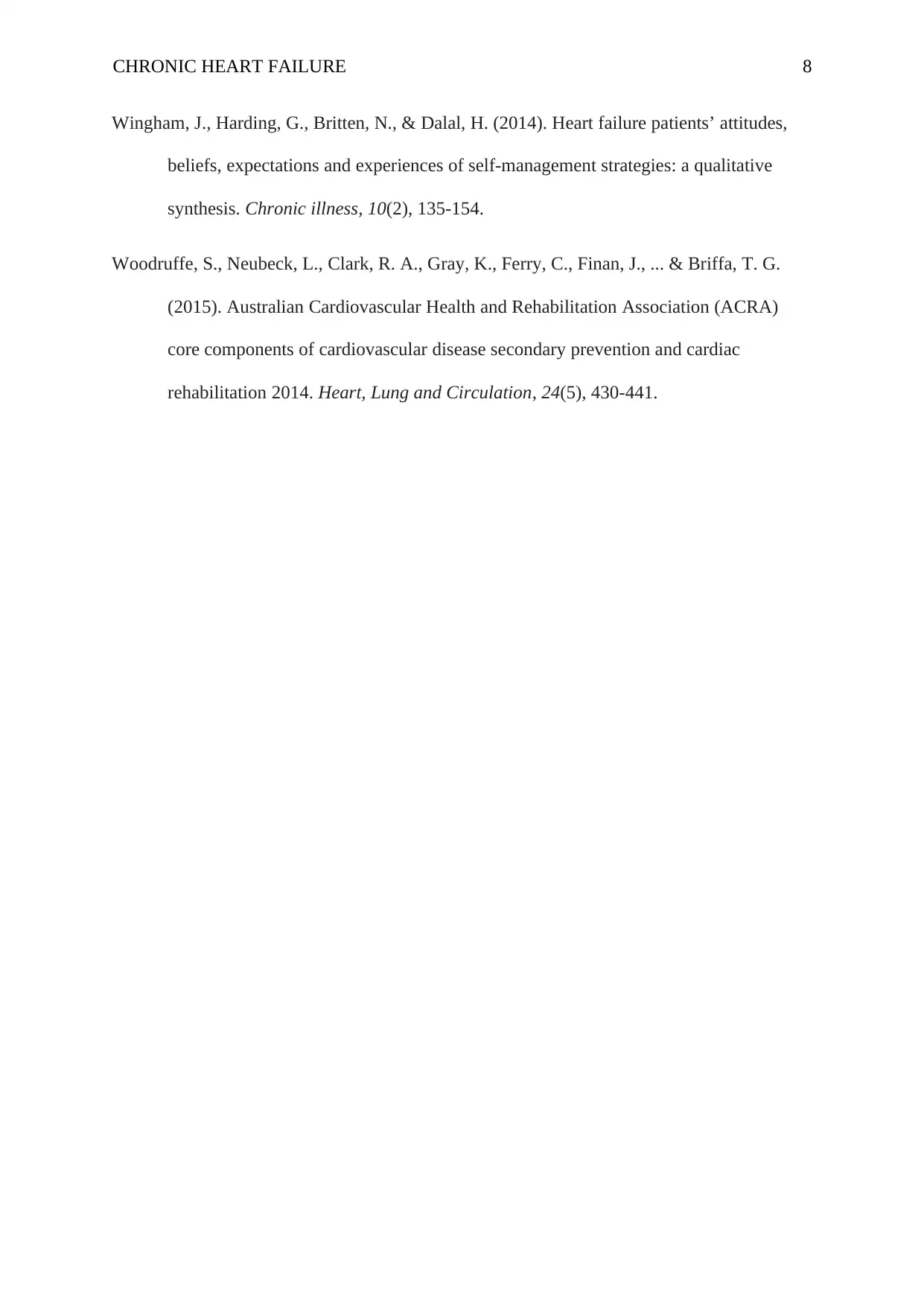
CHRONIC HEART FAILURE 8
Wingham, J., Harding, G., Britten, N., & Dalal, H. (2014). Heart failure patients’ attitudes,
beliefs, expectations and experiences of self-management strategies: a qualitative
synthesis. Chronic illness, 10(2), 135-154.
Woodruffe, S., Neubeck, L., Clark, R. A., Gray, K., Ferry, C., Finan, J., ... & Briffa, T. G.
(2015). Australian Cardiovascular Health and Rehabilitation Association (ACRA)
core components of cardiovascular disease secondary prevention and cardiac
rehabilitation 2014. Heart, Lung and Circulation, 24(5), 430-441.
Wingham, J., Harding, G., Britten, N., & Dalal, H. (2014). Heart failure patients’ attitudes,
beliefs, expectations and experiences of self-management strategies: a qualitative
synthesis. Chronic illness, 10(2), 135-154.
Woodruffe, S., Neubeck, L., Clark, R. A., Gray, K., Ferry, C., Finan, J., ... & Briffa, T. G.
(2015). Australian Cardiovascular Health and Rehabilitation Association (ACRA)
core components of cardiovascular disease secondary prevention and cardiac
rehabilitation 2014. Heart, Lung and Circulation, 24(5), 430-441.
1 out of 8
Related Documents
Your All-in-One AI-Powered Toolkit for Academic Success.
+13062052269
info@desklib.com
Available 24*7 on WhatsApp / Email
![[object Object]](/_next/static/media/star-bottom.7253800d.svg)
Unlock your academic potential
Copyright © 2020–2025 A2Z Services. All Rights Reserved. Developed and managed by ZUCOL.




